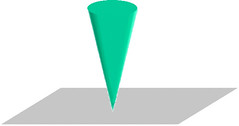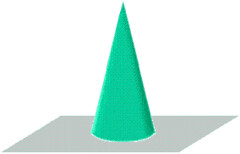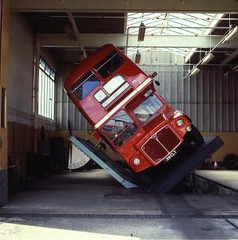Stable, Unstable and Neutral Equilibrium

A student playing with a pencil soon learns that it is scarcely possible to make it balance on its point. On the other hand, it is comparatively easy to make the pencil stand upright on a flat end.
In order to understand the difference between these two cases let us consider a wooden cone placed on a horizontal table.

1- unstable equilibrium
A cone cannot be made to stand on its tip. Theoretically, this feat might be possible if the cone could be placed with its center of gravity exactly in a vertical line through through the tip.
What are the forces involved here?
The cone would then be in equilibrium under the action of the force of gravity on it acting downwards and an equal and opposite reaction to its weight exerted on it by the table. But even if this condition could be achieved momentarily, the slightest vibration of the draught would inevitably cause the cone to tilt.
The force of gravity, W, would then exert a turning force about the tip, and this would cause the cone to topple over. A cone placed on its tip is said to be in unstable equilibrium.

2- Stable equilibrium
The image shows the cone standing on its base. If tilted from this position, even through a fairly large angle, the vertical line through the center of gravity, G, will still fall inside the base.
Consequently, the force of gravity on the cone will have a moment W × x about an edge of the base which will pull the cone back into its original position.
Under these conditions, it is not easy to knock the cone over, and it is said to be in stable equilibrium.

3- Neutral equilibrium
Now, the cone is lying on its side. the base is simply a straight line, and if the cone is rolled into a new position the vertical line through the center of gravity still continues to pass through exactly the same point in the base.
Whatever the position of the cone, the reaction from the table will act in the same straight line as the force of gravity through G, and so the cone will be in equilibrium. The force of gravity exerts no moment about the base as axis and, if displaced, the cone will therefore remain at rest in its new position. This condition is described as neutral equilibrium.
Stable and Unstable body
It should be clear from the above explanation that the stability of a body depends on the direction of the turning moment exerted by the force of gravity on the body about the edge of the base, when the body is given a small displacement.
If a small displacement brings the vertical through the center of gravity outside the base the body will be unstable. If, however, the vertical remains within the base the body will be stable.
When a displacement causes no change in the position of the vertical through the center of gravity with respect to the base the body is in neutral equilibrium.
Testing the stability

The photo illustrates the method of testing the stability of a bus.
The bus is undergoing the tilt test. The tilting platform is hydraulically operated and controlled from the console on the left, and the angle of tilt is measured by the indicators attached to the bus body and the side frame of the platform.
The fist indicator shows the angle of tilt of the body and the second that of the chassis, the difference being attributable to the vehicle springing. A double-decked vehicle must be stable with the chassis tilted to, say, 28° while the vehicle is loaded with weights to represent a full complement of passengers on the top deck only, plus the driver and conductor, at 64.5 kg per person. The two padded buffers on the side frame are to support the bus should it fall sideways during the test, but in actual fact the vehicle can be tilted well beyond the legally required angle before this happens.
